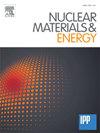The first application of flush probe arrays on HL-3 tokamak
IF 2.3
2区 物理与天体物理
Q1 NUCLEAR SCIENCE & TECHNOLOGY
引用次数: 0
Abstract
Newly flush-mounted Langmuir probe arrays are fabricated and applied in the HL-3 tokamak to investigate its advanced divertor physics such as snowflake and tripod divertors. Three sets of flush probe arrays are installed on toroidal ports 4, 10 and 18. Each port has 43 × 4 = 172 probe tips, which are composed of 43 triple and single probe arrays. Each array consists of 4 tips with the same major radius and height. A total of 516 CFC (carbon fiber composite) tips with diameter of dp = 4 mm are mounted at 3 ports. Their minimum spatial separation is 1.8 cm poloidally, while temporal resolution for ion saturation currents is 1 μs. The toroidal separation of a triple probe is 1.8 ∼ 3.8 cm or 10.2 ∼ 14.8 cm. It gradually increases with major radius. A novel design of ceramic isolation ring with a labyrinth can ensure reliable electrical insulation between the CFC tip and the divertor target plate where plasma dust and impurities are continuously deposited into their gaps due to long experimental operation. A large spring washer improves the heat conduction from each tip through a ceramic insulator into a cooled divertor copper plate. Every probe body is embedded into a divertor plate then brazed to a copper wire to ensure good electrical connection, and finally fixed on a stainless-steel support. Forty-three signal wires at the same toroidal angle are combined into a manifold copper tube to vacuum feedthrough, which can dramatically shield noise and resist the high baking temperature of 300 °C. Moreover, the discharge monitoring and mode conversion between the triple and single probes could be freely performed via a remote-control workstation. The first application results indicate that the target probe arrays can measure highly temporal plasma parameters, including electron temperature and density, particle and heat fluxes in H-mode discharges on HL-3 tokamak. The tripod divertor configuration has been confirmed by the new flush probe arrays.
求助全文
约1分钟内获得全文
求助全文
来源期刊

Nuclear Materials and Energy
Materials Science-Materials Science (miscellaneous)
CiteScore
3.70
自引率
15.40%
发文量
175
审稿时长
20 weeks
期刊介绍:
The open-access journal Nuclear Materials and Energy is devoted to the growing field of research for material application in the production of nuclear energy. Nuclear Materials and Energy publishes original research articles of up to 6 pages in length.
 求助内容:
求助内容: 应助结果提醒方式:
应助结果提醒方式:


